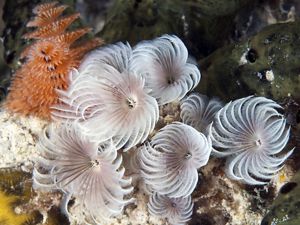Incredible ocean photos so you can see what your support protects.
Some of our favorite pictures that remind us how important the ocean is and why we must do more to protect it.
The majestic world under the sea has captivated the minds of many for centuries. Whether it’s the unique wildlife found beneath the waves or the sheer expanse of the open seas, the ocean is one of the most interesting and sought out places to explore.
In addition to providing us with beauty, the ocean functions as the heart of our planet—pumping oxygen, nutrients, water and weather around the globe.
The ocean is also one of our greatest allies against climate change, absorbing most of the excess heat and carbon dioxide in our atmosphere—but it’s been paying a steep price.
Warming, acidification and overfishing and pollution increasingly threaten the ocean’s ability to sustain us. That’s why The Nature Conservancy is working to protect 10% of the world’s ocean area by 2030.
This stunning collection of ocean photos provides a glimpse at the wonders beneath the waves and shows what your support is helping to protect.
COASTLANDS—A CLIMATE ALLY








Where the Land Meets the Sea
On the edges of the ocean, coastal wetlands—such as mangroves, salt marshes and seagrass meadows—help protect communities from climate-charged storms, sea level rise and erosion. They also draw in carbon as they grow and transfer it into their leaves, stems and the rich soils held by their roots.
To protect our coast and the value it provides to nature and people, we need innovative conservation and policy guided by science. In North America, The Nature Conservancy has incorporated strategies like the rebuilding of coastal reefs and other natural structures to help protect against sea level rise.
intimate snaps from the deep sea








Close Encounters
The reefs that cover less than 1% of the world’s surface area support 25% of all marine life. There are thousands of unique species to be found in these ecosystems and we’ve only just begun to discover and understand the relationships they have with one another and with their marine networks.
As the threats of climate change mount, we’re studying super reefs to find out why some are more resistant and resilient to damaging heatwaves.
Researchers are identifying where super reefs are located and which ones are best at spreading baby corals to other reefs. These efforts are vital for protecting the world’s reefs before they are lost.
Ocean animals on the go








Making Moves
Climate change has threatened migration for the many species that navigate thousands of miles underwater.
In Mexico, we’ve helped ensure the conservation of more than 34 million acres of marine areas. This protected habitat serves as a migratory route for dozens of species of sharks, rays, tuna, sea turtles and dolphins, vital breeding grounds for humpback whales and more than 400 fish species.
The Nature Conservancy and partners are improving migration for threatened species like the hawksbill turtle by using technology to determine where habitat conservation is most needed.
Protecting underwater habitat is vital








A Community Below
For the first time ever, Caribbean countries and territories have a clear picture of the habitats found beneath the waves. The Nature Conservancy has created detailed maps of coral reefs and other essential ecosystems throughout the entire Caribbean basin.
In an important stride for conservation, this high-resolution mapping effort significantly enhances our knowledge of the ocean to help us better protect coral reefs and other oases of marine life that sustain threatened species.
These revolutionary maps can transform the way resources are protected and managed for island nations in which 60% of living coral has been lost in the past few decades alone. This is vital for supporting endangered species—because we can now see which reef habitats are most threatened and in need of urgent help.
OCEAN PROTECTION MATTERS EVERYWHERE










In This Together
The whole ocean is connected, and nowhere is this fact more apparent than in the coastal fishing communities that feed our world.
While nearly half the planet’s population depends on fish for protein, food production has put major pressure on the ocean, pushing around 85% of commercially harvested fishery stocks to their breaking point.
Improving how we grow and catch our food can relieve this pressure and restore ocean health. Together, we can help protect and sustain ocean life and coastal communities for a bountiful future.

Everyone has a part to play in saving the heart of our planet. We must continue the hard work needed to combat these threats and protect our most cherished places.
In the next decade, The Nature Conservancy is working to protect people and nature by conserving 650 million hectares of healthy land, 30 million hectares of freshwater, and 4 billion hectares of oceans.
Through protected areas, sustainable fishing, forest management, and working with Indigenous peoples, it is possible to change the course of our future.
The ocean’s future is our future.
Sign up for our monthly Nature News updates to learn how we’re conserving the ocean and all that it provides.




